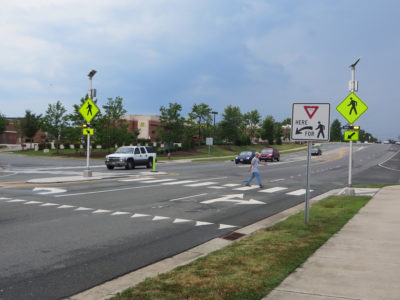
Senior Research Engineer Kay Fitzpatrick, nationally known pedestrian safety researcher at the Texas A&M Transportation Institute (TTI), is accustomed to phone calls from traffic engineers who want to discuss her lifesaving research results. She is expecting a lot more of those calls now that the Federal Highway Administration (FHWA) has issued Interim Approval 21 for a pedestrian traffic control device she’s extensively studied.
Fitzpatrick led several research projects on the Rectangular Rapid-Flashing Beacon (RRFB), a pedestrian-activated crossing warning sign. With FHWA’s interim approval, Fitzpatrick believes a lot more engineers will want to install the device.
“Two of those studies were referenced in the interim approval document,” Fitzpatrick explains. “Our research demonstrated that the RRFB shows a lot of promise in creating safer pedestrian and school crossings, in some cases. But the RRFB is not a panacea. There are conditions where it may not be very effective based on our studies that focused on driver yield rates, which varied dramatically depending on the individual pedestrian crossing.”
The project—Will You Stop for Me? Roadway Design and Traffic Control Device Influences on Drivers Yielding to Pedestrians in a Crosswalk with a Rectangular Rapid-Flashing Beacon—was funded by TTI’s Center for Transportation Safety in 2016 and analyzed data collected that year along with data from previous research. The research team discovered some of those variables that could have an effect on driver yielding.
“When I talk to engineers interested in the RRFB device and our research, I emphasize the use of caution,” Fitzpatrick says. “Our research did not answer all the questions, and it’s clear that additional studies are needed to determine under what conditions this particular traffic control device is most effective.”